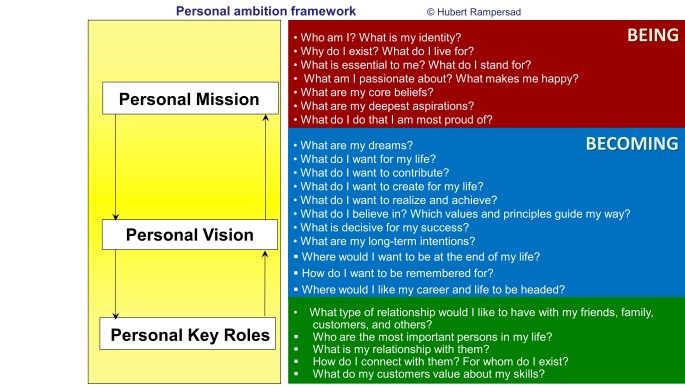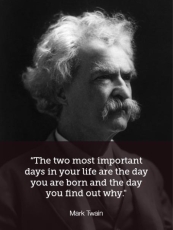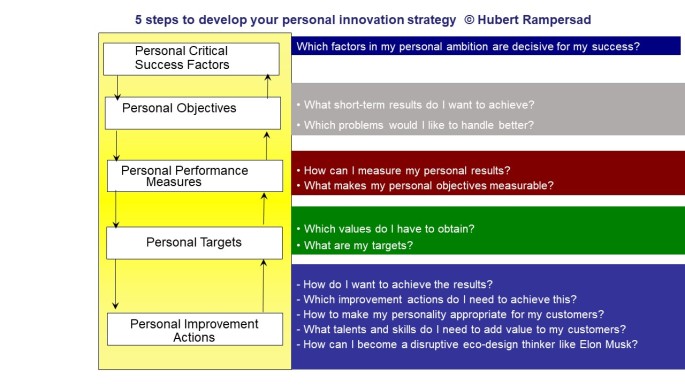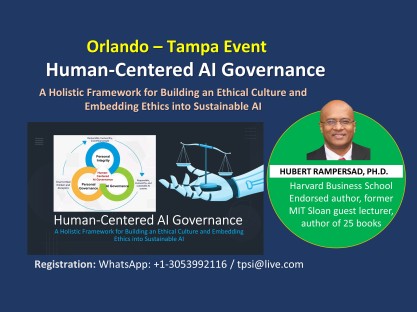Creativity is the ability to think about a problem in a new way and use imagination to come up with innovative ideas. Conventional creative processes often fail to ignite the necessary spark of imagination and critical thinking. Interestingly, the best ideas come when you are alone. Regrettably, many organizations prioritize theatrical group brainstorming sessions over genuine sustainable creativity development. It’s important to note that cozy meetings are not essential for generating innovative ideas. Creative potential is the ability to generate innovative ideas and solve problems innovatively.
Holistic model to unlock your creative potential
This article introduces a holistic model to unlock your creative potential and encourage personal growth and unconventional thinking. This model is based on my latest book, “Eco-Design Thinking for Personal, Corporate, and Social Innovation.” It involves five steps: 1. Personal Ambition, 2. Personal Brand, 3. Personal Innovation Strategy, 4. Implementation, and 5. Personal Integrity & Empathy. This model is illustrated below:
latest book, “Eco-Design Thinking for Personal, Corporate, and Social Innovation.” It involves five steps: 1. Personal Ambition, 2. Personal Brand, 3. Personal Innovation Strategy, 4. Implementation, and 5. Personal Integrity & Empathy. This model is illustrated below:

This model will help you develop visionary, imaginative, and empathetic thinking. Instead of thinking outside the box, you’ll think like there is no box. The key is to develop self-knowledge and self-learning to drive personal innovation, which can help you become more resilient and authentic and sharpen your authenticity, integrity, empathy, and critical thinking skills. Remember that without self-knowledge, personal innovation, a strong mindset, and personal integrity, you won’t be able to succeed as an empathetic and disruptive innovator. This system will unlock your creative potential and imagination while honing your authenticity, integrity, empathy, and critical thinking skills. It will guide your beliefs and actions, helping you discover your purpose in life and leading to a more fulfilling, content, and healthier life, personally and professionally.
Personal disruptive innovation is a system that helps you explore and redesign your life, build resilience, and develop your personal brand. It enables you to define your higher calling and discover your life’s purpose. Elon Musk once said: “Attach yourself to a mission, a calling, a purpose only. That’s how you keep power and your peace. It worked pretty well for me this far”. Using the personal disruptive innovation model, you can become a visionary, imaginative, and empathetic individual. This involves using self-learning to translate your self-knowledge into personal innovation and to develop skills such as resilience, authenticity, integrity, strategic thinking, and critical thinking, which are crucial in the AI era. This system will also help unleash your creative potential and imagination and will help you skillfully analyze information from observation, experience, reflection, and reasoning.
The model consists of the following five phases:
- Personal Ambition: The initial step involves engaging in a reflective process that includes deep thinking, introspection, and self-reflection. This will also strengthen your critical thinking skills. During this phase, you’ll be introduced to breathing and silence exercises that will aid in developing self-awareness. Self-knowledge is the ultimate goal of this phase. The outcome of this phase will be the creation of your personal mission, vision, and key roles, as illustrated in the diagram below. Remember what Elon Musk said: “Don’t even attach yourself to a person, a place, a company, an organization, or a project. Attach yourself to a mission, a calling, a purpose only. That’s how you keep power and your peace. It worked pretty well for me this far”. Your personal ambition statement also serves as the foundation of an innovative, creative, imaginative mindset. The figure below shows the personal ambition framework. Ask yourself these questions and answer them honestly.

By practicing breathing and silence exercises, you can better connect with your inner self and find answers to these questions. This will help you to discover your higher purpose. Through this process, you’ll cultivate self-knowledge, self-awareness, self-management, and self-learning, which entails a journey toward personal disruptive innovation, as shown in this diagram:

The best ideas come when you are alone. Self-learning – the ability to gather, process, retain, and evaluate knowledge alone — is the foundation of creativity and imagination. Traditional creativity approaches lack imagination because they neglect self-learning and, because of this, fail to address complex problems. They heavily rely on group meetings and, therefore, miss opportunities to develop innovative and imaginative ideas. Nikola Tesla developed many innovative ideas while working alone for over thirty years. Similarly, Stephen Hawking made significant discoveries while confined to his wheelchair, and Isaac Newton famously discovered gravity while in social isolation. Remember Nikola Tesla’s statement: “Being alone is when ideas are born. This is the secret of innovation”. Albert Einstein said almost the same: “Albert Einstein said almost the same: “Be a loner. That gives you time to wonder, to search for the truth. Have holy curiosity. Make your life worth living”.
Remember Nikola Tesla’s statement: “Being alone is when ideas are born. This is the secret of innovation”. Albert Einstein said almost the same: “Albert Einstein said almost the same: “Be a loner. That gives you time to wonder, to search for the truth. Have holy curiosity. Make your life worth living”.
Spirituality can play a vital role in eco-design thinking and innovation. It provides the intuition needed to make tough decisions and develop a higher level of consciousness. Elon Musk once said, “We should aspire to increase the scope and scale of human consciousness to understand better what questions to ask. The only thing that makes sense It is to strive for greater collective enlightenment.” By focusing inwardly and reflecting on your actions through self-examination with breathing and silence exercises, you can gain insights about yourself and your life’s purpose. This is what Einstein wanted to know.
It is to strive for greater collective enlightenment.” By focusing inwardly and reflecting on your actions through self-examination with breathing and silence exercises, you can gain insights about yourself and your life’s purpose. This is what Einstein wanted to know.
You will also find out why you were born. This process will help you learn more about yourself and discover the truth about your life’s purpose. As Thomas Huxley said, “Learn what is true to do what is right.” This process enables you to learn more and discover the truth about yourself. By formulating personal ambition, you can initiate self-examination and prepare your mindset for critical thinking. As you become more conscious of yourself, gain more creativity, and become a critical thinker. The thinking process and mindset changes are meant to prepare you for action as a proactive, empathic, and ethical critical thinker. Based on insights acquired through this process, you will also become more self-assured and work smarter through self-learning and self-knowledge. You become more creative and innovative as you grow more conscious of yourself. The words of Galileo Galilei may also be
become more conscious of yourself, gain more creativity, and become a critical thinker. The thinking process and mindset changes are meant to prepare you for action as a proactive, empathic, and ethical critical thinker. Based on insights acquired through this process, you will also become more self-assured and work smarter through self-learning and self-knowledge. You become more creative and innovative as you grow more conscious of yourself. The words of Galileo Galilei may also be recalled here—“You cannot teach a man anything; you can only help him discover it in himself.” Remember, the more you want to be innovative, the more you should develop self-knowledge. Read “How Mindful Meditation Boosts Critical Thinking in the Age of AI.”
recalled here—“You cannot teach a man anything; you can only help him discover it in himself.” Remember, the more you want to be innovative, the more you should develop self-knowledge. Read “How Mindful Meditation Boosts Critical Thinking in the Age of AI.”
By practicing breathing and silence exercises, you can better connect with your inner voice and find answers to the questions you seek. This requires tuning into the same wavelength as your spirit, which is closely linked to the concept of synchronicity. Synchronicity refers to meaningful coincidences or events that co-occur without apparent. It is the connection between the ‘inner world’ and the ‘outer world’; consciousness bridges these two dimensions. Synchronicity can manifest in many ways, and it is a phenomenon studied by psychologists such as Carl Gustav Jung and Nikola Tesla, who were also in sync with the universe. I am also acting like a receiver and tuned to the same frequency.
It is the connection between the ‘inner world’ and the ‘outer world’; consciousness bridges these two dimensions. Synchronicity can manifest in many ways, and it is a phenomenon studied by psychologists such as Carl Gustav Jung and Nikola Tesla, who were also in sync with the universe. I am also acting like a receiver and tuned to the same frequency.
Your personal ambition comprises your mission, vision, and key roles. You can click on this link to view my personal ambition statement. Having a clear purpose is crucial to becoming a visionary. Elon Musk’s vision is to contribute to the world’s shift from fossil fuels to sustainable energy sources. According to Musk, the thing that drives him is vision. He said, “I think having an inspiring and appealing future is important. There must be reasons you get up in the morning and want to live. Why do you want to live? What’s the point? What inspires you? What do you love about the future?”
2. Personal Brand: In this phase, you will define and formulate an authentic, distinctive, memorable personal brand promise to strengthen your authenticity, integrity, empathy, and critical thinking skills. This brand promise will be the focal point of your storytelling throughout each stage of my new proposed design process and your interaction with AI. Storytelling is an essential tool that can be used to engage with customers at different stages of the design process. Take the time to create your brand statement, ensuring it aligns with your ambition. Then, craft a compelling brand story to promote the brand called “You.” Elon Musk is an excellent example of a powerful personal brand and a brilliant storyteller. He emotionally connects with his audience by sharing his vision and passion for innovation. ChatGPT can assist you in creating compelling brand stories that resonate with your audience and convey your brand message effectively. This figure shows the seven steps to develop your authentic personal brand, which will strengthen your critical thinking skills. Following these steps, you can create a personal brand that reflects your values, strengths, and aspirations and helps you stand out in a crowded market. Read also “Crafting Your Authentic Personal Brand: A 5-Step Guide“. Please click on this link to view my personal brand statement. 
3. Personal innovation strategy: To bring your personal ambition to life, it’s crucial to act. This means creating a well-rounded action plan or personal innovation strategy based on your mission, vision, and key roles. A personal innovation strategy includes a roadmap to help you develop a stronger mindset and authenticity, integrity, empathy, and critical thinking skills. Without continuous improvement based on your personal innovation strategy, you won’t be able to assist AI effectively, and this will not lead to your long-term growth and success. The following are the five steps to develop your personal innovation strategy:
Your personal critical success factors are the key elements of your ambition and objectives. These factors are broken down into four perspectives: internal, external, knowledge and learning, and financial. Your personal innovation strategy helps you turn your personal ambition into manageable, measurable objectives and milestones in a balanced way. Using this strategy, you can effectively manage your time and become more disciplined, proactive, innovative, and empathetic. If you want to learn more about this personal innovation strategy system, I recommend reading my article “How to Redesign Your Life Based on Your Personal Innovation Strategy.” This article provides valuable insights on how to stay on track and avoid becoming obsolete. It’s an excellent resource for anyone who wants to become a disruptor like Elon Musk. Please click on this link to view my personal innovation strategy.
“How to Redesign Your Life Based on Your Personal Innovation Strategy.” This article provides valuable insights on how to stay on track and avoid becoming obsolete. It’s an excellent resource for anyone who wants to become a disruptor like Elon Musk. Please click on this link to view my personal innovation strategy.
4. Implementation: Once you have established your personal innovation strategy, it is essential to consistently implement, maintain, and cultivate it to effectively manage and challenge yourself in your personal and business life. To aid you in this process, I recommend following the PDAC cycle (Plan-Deploy-Act-Challenge), which is a continuous improvement cycle that will help your personal innovation strategy effectively, as illustrated in this diagram:

Implementing your personal innovation strategy through the PDAC cycle will lead to self-awareness, happiness, personal disruption, and enhanced authenticity, integrity, empathy, and critical thinking skills. It’s important to regularly update your personal innovation strategy and repeat the cycle to stay current with new challenges and lessons learned. Continuous self-improvement is necessary to become a successful eco-design thinker like Elon Musk. These 50 tips will assist you in implementing your personal innovation strategy effectively.
strategy and repeat the cycle to stay current with new challenges and lessons learned. Continuous self-improvement is necessary to become a successful eco-design thinker like Elon Musk. These 50 tips will assist you in implementing your personal innovation strategy effectively.
5. Personal integrity & empathy: In this age of AI, it is essential to have personal integrity and empathy to assist generative AI systems effectively. Generative AI systems like ChatGPT have been known to inherit and perpetuate biases in training data, propagate hate speech and false information, and even generate content that could potentially raise copyright issues. To avoid these issues, it is crucial to reskill and upskill users to enhance their integrity and empathy skills. By demonstrating personal integrity, users can positively impact their relationships with AI and foster empathetic behavior. This figure illustrates this personal integrity concept:
 AI users must balance their personal ambition with their current behavior and actions to develop personal integrity and empathy. Finding a balance between personal ambition and actions is crucial to achieving sustained personal integrity and empathy. During this alignment process, it is essential to reflect honestly on the following questions: What are my personal values, and how do they align with my actions? How can I ensure that my actions are consistent with my values? What are the potential consequences of my actions toward others? How can I empathize with others and understand their perspectives? Am I staying true to my values and conscience in my actions? Are my thoughts and actions aligned consistently? How do my values and intentions relate to my current behavior? Is there congruity between my thoughts and my actions? Am I always acting according to my personal ambition and empathetic nature? Does my personal ambition reflect my desire to work with ethics and empathy? Are there any discrepancies between my personal ambition and my empathetic actions? Do I keep the promises I make to myself? How do others perceive me and my values? Do they see me as someone who stays true to my core beliefs and remains authentic to myself?
AI users must balance their personal ambition with their current behavior and actions to develop personal integrity and empathy. Finding a balance between personal ambition and actions is crucial to achieving sustained personal integrity and empathy. During this alignment process, it is essential to reflect honestly on the following questions: What are my personal values, and how do they align with my actions? How can I ensure that my actions are consistent with my values? What are the potential consequences of my actions toward others? How can I empathize with others and understand their perspectives? Am I staying true to my values and conscience in my actions? Are my thoughts and actions aligned consistently? How do my values and intentions relate to my current behavior? Is there congruity between my thoughts and my actions? Am I always acting according to my personal ambition and empathetic nature? Does my personal ambition reflect my desire to work with ethics and empathy? Are there any discrepancies between my personal ambition and my empathetic actions? Do I keep the promises I make to myself? How do others perceive me and my values? Do they see me as someone who stays true to my core beliefs and remains authentic to myself?
To enhance empathy and personal integrity, aligning your personal ambition with your behavior is essential. This involves achieving more excellent compatibility between the two elements so that they are in harmony, as shown below. When your personal ambition and behavior match, you can work authentically and purposefully toward using AI systems without any internal conflicts. This will lead to greater empathy, enhanced charisma, transparency, and trustworthiness.
It is essential to ensure harmony between your personal ambition/brand and your actions to align your deeds with your conscience. Our conscience is the inner voice that guides us to distinguish between right and wrong, fact and fiction. By listening to this voice, we can gain better insight into our empathic behavior, strengths, and weaknesses, ultimately impacting our solidarity with others. Albert Schweitzer once said: “The first step in the evolution of ethics is a sense of solidarity and empathy with other human beings.”
It takes constant awareness of how our actions affect other people, animals, plants, and the environment to achieve a balance between personal ambition and behavior. This entails encouraging social innovation and exercising social responsibility. Our ethical and compassionate conduct improves as we become more aware while our conceit and haughtiness diminish. In addition to offering a breathing and silent exercise, my book can encourage this attentiveness by having readers consider how their conduct and personal aspirations align. By doing this, we may improve and establish a solid personal brand. We must question ourselves honestly: Have I always acted by my conscience? Have I always done what was right? Have I always acted morally as an AI user? Have I acted compassionately regularly? Remember: “Personal integrity and honesty are two important values to uphold in the AI industry, but they differ. Honesty is about telling the truth to others, while personal integrity is about being truthful to yourself and staying true to your values and principles. It’s important to be honest with others, but it’s more important to be honest with yourself and live your life by your beliefs and values,” — Hubert Rampersad
Read also “Sustainable Innovation Fueled by Purpose-Driven Culture”.

Hubert Rampersad, Ph.D.
To gain more knowledge about this subject, you may consider attending his Orlando-Tampa Live Events:
Building a Purpose-Driven and Design-Driven Culture in Tech Companies

Purpose-Driven and Human-Centered AI

Cultivating Authenticity, Integrity, Empathy, and Critical Thinking in the Age of AI.
How Sustainability and Generative AI Fuel Design Innovation.
We also offer the Certified Authentic AI Leadership Coaching program. This program is appropriate for AI leaders, managers, and professionals who wish to strengthen their ethical leadership and critical thinking skills, drive their purpose and human-centeredness, and coach others to realize the same.
Hubert Rampersad, Ph.D., founded the Center of Excellence in Human-Centered and Purpose-Driven Innovation in Orlando. He is a Dutch-American visionary leader in innovative solutions for genuine sustainability, disruptive design innovation, critical thinking in the age of AI, human-centered and purpose-driven AI, and entrepreneurial leadership. He holds a Ph.D. in Innovation Sciences, an MSc in Technology Engineering & Robotics, and a BSc in Mechanical Engineering from leading accredited universities in the Netherlands (Delft University of Technology, Eindhoven University of Technology). He is a well-known futurist, advocating for genuine sustainability on a global scale. With extensive knowledge and expertise, he has authored 25 books on the topics above in many languages and is highly regarded for his insights in these fields. One of his books, “Total Performance Scorecard,” has been published in 20 languages. Dorothy Leonard, an innovation professor at Harvard Business School, wrote the book’s foreword. Rampersad has also previously served as a guest lecturer at MIT Sloan and was featured in BusinessWeek. He was a senior design innovation coach at ASML, the most important tech company in the world and “Europe’s most valuable tech firm“.

Orlando, Florida | tpsi@live.com | Phone/WhatsApp: +13053992116






